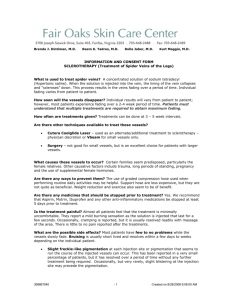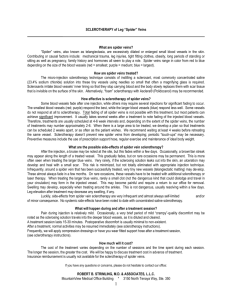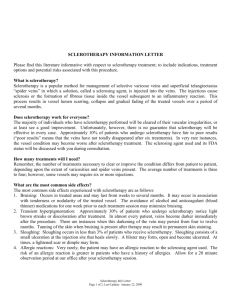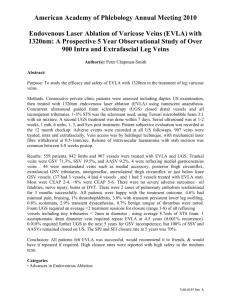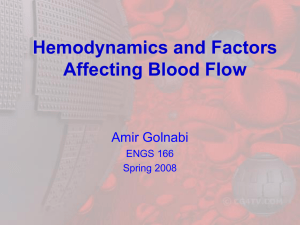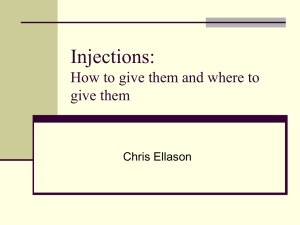sclerotherapy instructions
advertisement
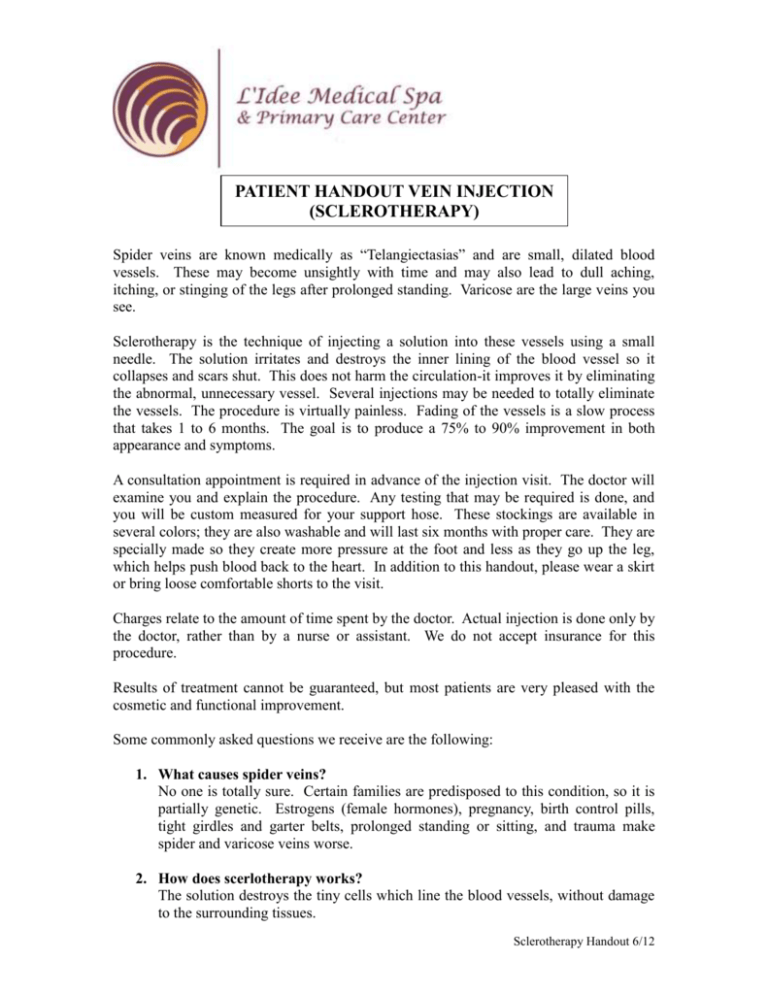
PATIENT HANDOUT VEIN INJECTION (SCLEROTHERAPY) Spider veins are known medically as “Telangiectasias” and are small, dilated blood vessels. These may become unsightly with time and may also lead to dull aching, itching, or stinging of the legs after prolonged standing. Varicose are the large veins you see. Sclerotherapy is the technique of injecting a solution into these vessels using a small needle. The solution irritates and destroys the inner lining of the blood vessel so it collapses and scars shut. This does not harm the circulation-it improves it by eliminating the abnormal, unnecessary vessel. Several injections may be needed to totally eliminate the vessels. The procedure is virtually painless. Fading of the vessels is a slow process that takes 1 to 6 months. The goal is to produce a 75% to 90% improvement in both appearance and symptoms. A consultation appointment is required in advance of the injection visit. The doctor will examine you and explain the procedure. Any testing that may be required is done, and you will be custom measured for your support hose. These stockings are available in several colors; they are also washable and will last six months with proper care. They are specially made so they create more pressure at the foot and less as they go up the leg, which helps push blood back to the heart. In addition to this handout, please wear a skirt or bring loose comfortable shorts to the visit. Charges relate to the amount of time spent by the doctor. Actual injection is done only by the doctor, rather than by a nurse or assistant. We do not accept insurance for this procedure. Results of treatment cannot be guaranteed, but most patients are very pleased with the cosmetic and functional improvement. Some commonly asked questions we receive are the following: 1. What causes spider veins? No one is totally sure. Certain families are predisposed to this condition, so it is partially genetic. Estrogens (female hormones), pregnancy, birth control pills, tight girdles and garter belts, prolonged standing or sitting, and trauma make spider and varicose veins worse. 2. How does scerlotherapy works? The solution destroys the tiny cells which line the blood vessels, without damage to the surrounding tissues. Sclerotherapy Handout 6/12 3. How soon will the vessels disappear? Each vessel usually requires one to three treatments. The vessels disappear over a period of 2 to 3 months. Recurrences may rarely occur over a period of 1 to 5 years. This treatment does not prevent new vessels from developing. 4. Are there certain vessels which tend to recur more commonly? Yes. There are types of vessels which occur in a mat of very fine radiating vessels. This can occur on its own or may even come on after the injection itself. Large veins also may not respond well to injections. 5. How often can I be treated? The same area should not be injected for 3 to 4 weeks to allow for complete healing. Different areas may be treated every week if necessary. 6. How often can I be treated? This varies with the number of areas that have to be injected, how numerous the veins are, their size, as well as the response to each injection. It usually takes one to three injections to obliterate any vessel; 10 to 40 vessels may be treated in any one session. 7. Are there certain kinds of spider veins that can’t be treated? Certain types of large varicose veins may not respond readily to sclerotherapy alone. These vessels may require a minor surgical procedure to remove them with follow-up sclerotherapy for the smaller vessels at a later time. You may be referred to vascular surgeon for complete or partial treatment of these specific types of large varicose veins. Some of the extremely small vessels (less than 1/1000 of a millimeter) we may recommend treatment with a pulsed dye laser. Vessels on the face do better with different treatments than sclerotherapy. 8. Are there other methods of treating these vessels? Three other methods are used: A. Laser surgery To date, this method has only been effective for tiny blood vessels. The present laser systems tend to produce greater risk of scarring. The laser is an expensive devise and treatment is thus more costly. B. Electrodessication or cautery This method produces non-specific destruction of both the vessel and overlying skin, thus resulting in a greater incidence of scarring. It does work well on the face not the legs. C. Surgical ligation and stripping This operative produce is carried out in an operating room. It is best reserved for large varicose veins. Sclerotherapy Handout 6/12 9. Is there any way to prevent spider veins? The use of support hose may be helpful. Reducing your weight and exercising regularly will also decrease your changes of spider veins. 10. What are the side effects to injection treatment? A. Slight stinging or burning may occur with injection of certain types and concentrations of solutions in certain areas. B. Sometimes a clot develops at the injection site (especially if the recommended pressure stockings are not worn for the proper amount of time or if large veins are injected). This clot will not generally cause internal problems, but its removal within 2 weeks of the injection will speed the healing process and decrease the incidence of discoloration. Removal is simple and only requires a minute incision. C. Swelling over the injection site may rarely occur. It is particularly common when patients have jobs which they stand for long periods of time or when vessels in the ankles are injected. The swelling is rarely dangerous but occasionally must be treated with elevation and compression dressing. D. Superficial throbophlebitis, an irritation of the injected vessel, occurs in less than 1 per1000 patients. It may have to be treated with antiinflammatory agents and compression stockings. E. 10 % to 30% of patients develop a small freckle-like tan to brown spot around the injection vessel. This usually resolves in 80% of these patients within 3 to 6 months. A few patients will have a persistent discoloration for up to a year. F. A small superficial ulceration of the skin overlying the injection vessel may occur. This does not usually leave a scar but needs to be seen as soon possible by your doctor. It can take 6-8 weeks to heal. G. Sometimes the body replaced the injection vessel with a “mat” of very fine vessels causing an apparent darkened area. This may need follow-up injections. H. The injected sites will definitely look worse for a few weeks before they look better! 11. What should I do before my appointment for treatment? a. Discontinue aspirin and blood thinners 1 week prior to your appointment. b. Do not shave your legs for 2 days prior to your appointment. Do not apply any creams or lotions on the day of injection. c. Eat a light breakfast or lunch an hour or so prior to your appointment. Bring loose shorts to wear during the procedure and slacks to wear out of the office since there will be bulky bandages. 12. What should I do after the procedure? a. Walk for 30 minutes immediately following the injections. Sclerotherapy Handout 6/12 b. While riding home, keep kegs moving. Tense up and relax your muscles. Make frequent stops for walking (every 20 minutes) if it’s a long drive. c. Maintain normal daytime activities; walk at least an hour a daythe more the better. d. No hot baths for two weeks. e. Avoid standing without moving about. If you must stay in one place, move your feet and topes frequently. f. If the legs become painful after the injection, walk during the day for three days. Larger veins may require more walking. g. Avoid strenuous physical activity (aerobic) for the first 72 hours. h. After the first 2 days, you may remove the stockings at night but it is recommended that you wear them when not reclining for at least 3 weeks. Ideally you would use support hose the rest of your life. 13. Remember that injection therapy is only treating the symptoms. Whatever the cause of your abnormal veins is, it’s still there after injections. New abnormal veins can form and may recur, requiring future treatment in 1-2 years. Wearing support hose regularly may reduce the need for repeat follow up treatments. 14. I regularly refer to a vascular surgeon for complicated cases. The surgeon is willing to consult prior to any treatment here and is also available to do the injections right from the beginning if you prefer. In most instances you are expected to pay on the day of the visit. Sclerotherapy Handout 6/12
